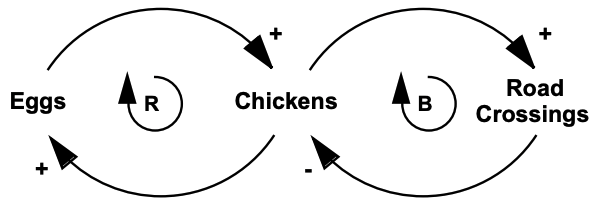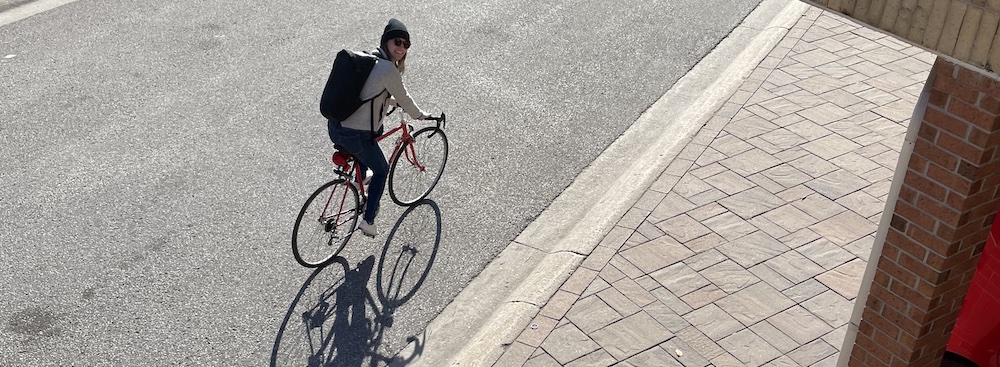Learning about systems thinking has changed the way I view and approach problems and has enabled me to challenge my own and others' perspectives.

Many leaders within organizations are not able to face reality, especially during the Covid-19 pandemic and now the aftermath. They are holding onto the past and thinking we can somehow go back to the way things were. Meanwhile, others are living their new reality with many feeling a major disconnect from their employer. Too often organizations look at the symptoms, zooming in on the smaller parts of the whole, rather than taking a systems thinking approach which zooms out to see the whole and highlights how the parts come together through connections and interactions to make a unified system.
"Living systems have integrity. Their character depends on the whole. The same is true for organizations; to understand the most challenging managerial issues requires seeing the whole system that generates the issue." - Peter Senge
Let’s walk through a real-life example of a company that is failing to take a systems thinking approach to fixing an outdated and broken system.
A friend and a past colleague of mine, we’ll call her “L”, is currently experiencing this disconnect from her employer and has given me permission to recount her story.
The initials used do not represent the names of the individuals involved. For your reference,
L = Product Manager
N = Director (L's manager)
E = VP (N's boss)
R = SVP (team leader)
F = Past colleague and friend
"L" knew she always wanted to move home to Montreal and the pandemic accelerated this thought into reality. I remember the happiness she exuded when speaking of buying her new home in a place that excited her. A fellow colleague of hers had recently done the same without issue so she assumed she would experience the same treatment given they both worked for the same organization. After being verbally told by "N" that her move to Montreal was acceptable, "L" packed her bags and headed toward her new home.
It was time for "L" to go on a new adventure and she was ready for this change. There's a lot of fear and resistance around change within many of us. Change can be daunting, but I truly stand behind it because I have grown the most from change. I recall an ex-partner's parents telling me to find a "good" job and stay in it, just like they did. While this approach works for some, this wasn't my path. My path has taken me to six companies in eleven years, providing me with positive and lasting outcomes; skill growth, cross-industry experience, lasting friendships and meeting my partner "S".

A couple of weeks later, "L" was informed by “N” that she would actually be losing her job by the end of the year if she didn't return to Toronto. Say what?! "E", who was providing this directive had earlier stated that she wanted people to come back to the office. Like many of us “L” had been working from home for the past 18-months, remaining productive and meeting goals. “N” informed “L” that she was in breach of her contract by living and working from Montreal.
I'm assuming a lot of this pressure was coming down from the C-level leadership team because their current (and outdated) business model is dependent on companies filling their office spaces. It's clear that they are taking a fear-based approach to leadership. Gather the troops back to the office or else there will be consequences!
When top-level leaders make poor decisions it impacts everyone. We need strong managers and leaders to push back on decisions that they know will negatively impact individuals. We need leaders who are not afraid to stand up for fairness. These types of organizations can heal, but it has to start from the top.
During this time "E" posted on Linkedin about Brene Brown having a lot to say about leadership and vulnerability and encouraging others to check it out. I laughed out loud. Did she read the article and forget everything or was this all for show? This is the same VP that had no interest in hearing why I had chosen to resign from my role. Opinions and feedback that challenge the status quo were not welcome.

They provided “L” with an end date of January 10, 2022, a date "E" had set in her own mind as to when she wanted her team back in the office. The downward spiral continued; "E" demanded "L" come back to Toronto for a Design Thinking workshop that was taking place on a Friday afternoon. A meeting that almost everyone else was attending virtually including the vendor who was leading the workshop. All expenses paid, for what? To prove a point, but what was the point? "L" did as she was asked and ended up sitting in a meeting room with "N" and "E" who each joined the workshop on their individual laptops. “L” did her best to reframe the situation and took the trip to Toronto as an opportunity to catch up with her friends before heading home.
A week later, “L” was informed that her current role would be reposted at a senior level and higher pay grade but with the same responsibilities. It felt like each week there was a new emotional blow to “L”. Showcasing power in the form of treating someone unfairly and inflicting emotional pain is completely unnecessary and unethical.
The threats continued, now in the form of repayment of a course fee if “L” left before December. I detest when money layden organizations try to take money back from employees. This happened to me when I resigned from one of my first jobs; the course fee was taken off my final paycheck. They didn't care that I could have really used that $1000 for my rent. These companies put roadblocks in the way of their employees' growth and overall well-being. Whether someone chooses to stay in an organization or move onto a new opportunity, they should not be penalized and threatened. Growth of any kind should always be celebrated with no strings attached.
This was all happening around the time when “L” was leading one of the biggest releases for her product. Loyally standing by the product’s success as her leaders threatened and inflicted emotional pain upon her. Post release, "R" sent out a congratulatory email to the whole company, listing the main people involved, with “L” being left off that list. Job title’s mean nothing; actions are everything.
"Face reality as it is, not as it was or you wish it to be." - Jack Welch, ex-CEO of GE -
Through all of this emotional turmoil, “L” requested, on multiple occasions, a letter outlining the details of what was being verbally stated. Many weeks passed and no sign of a letter. “L” never received any documentation outlining the situation, instead “N” delivered another message on behalf of "E" telling “L” that she should resign gracefully or she would be fired without cause and have to pay back the course fee. Oh, and her discretionary bonus amount would be negatively impacted. Threat after threat.
A friend and past colleague of ours, “F”, has been along for the ride on this one. The three of us used to share an office and would often close the door and have "therapy" sessions. We no longer work together but we've been meeting virtually once every few weeks to catch up, vent and be there to support one another through personal and professional experiences. “F” recommended to “L” that she speak with an employment lawyer to understand her options. A wise woman who also reminded “L” that she owes the company NOTHING. “Repeat after me, you owe them NOTHING!”
“L” got in touch with a lawyer whose reaction was “do not resign”, which was also my first reaction. He told “L” to document her verbal conversations and provided her some other information that he hoped would help.
“L” asked if we could chat because she felt stuck. Should she listen to the lawyer and fight for 3 more months of pay, or should she close the painful chapter ASAP and move on to better things. Most of you know that I like to fight for fairness. I told “L” of my own resignation story from six years ago where I resigned and then proceeded to book a meeting with the SVP of my department to discuss the unfair treatment by my leader. A leader that blackmailed my team into raising our very low team engagement score or we would forfeit a piece of our bonus. My question was how can an individual contributor raise a team’s engagement score? That’s what a leader is supposed to do. Although no action was taken toward my boss, I was proud of myself for speaking up. I never regretted telling the truth and felt even better the day I said my goodbyes. A similar but different situation.
While we can share experiences and wisdom, we can’t know exactly how someone is feeling or what’s best for them. I asked “L” what her gut was telling her to do. She knew what was happening was wrong and was open to sharing this experience with anyone who asked about her unexpected departure. She didn’t want to stay at a company that treats people so poorly and said her gut was telling her to focus on finding a new and exciting opportunity. With this in mind, as much as I struggle with an organization getting away with this type of behaviour, sometimes fighting back doesn’t achieve justice and continues inflicting pain on people that don’t deserve it. Sometimes it’s best (for our mental health) to walk away.
"L" is a hard-working, kind, generous, thoughtful and extremely smart woman. Someone who I know will be stronger because of this experience and will certainly find a much better and more forward-thinking company.
We need to support each other through these situations and talk more publicly about them because this type of unfair treatment in the workplace has to stop for the health of the employees and the organization.
"The inability to see things as an interconnected whole, as a system, negatively impacts individuals' physical and mental health, the health of relationships and the health of organizations. Without a systemic understanding, without being able to recognize structures and see things as a whole, we cannot deeply understand the way we, others, or the world works." - Tal Ben Shahar
So how do we know if we are working with a system? A good place to start is to ask the question, does anything important change if you take away or add parts or if the parts can operate on their own. For example, if you remove a hand from a body, the hand won’t function in the same way it used to, because every part of the body system has certain capacities that it loses when separated from its system (Sweeney, 2001).
Most systems have a purpose in relation to the larger system that they are embedded in. For example, departments within an organization often have different purposes. Understanding the different purposes which may be conflicting allows you to start uncovering why a system functions in a particular way and then how you might help it function better, which might include reorganizing a company structure so that conflicting teams share similar goals.
Systems thinkers don’t think of causality (cause and effect) in a linear fashion, instead they think of it in a circular shape known as feedback loops. A feedback loop occurs when a change in something ultimately comes back to cause a further change in the same thing. There are two types of feedback loops; reinforcing loops and balancing loops. A reinforcing feedback loop is one in which more leads to more and less leads to less. It can cause dramatic growth or collapse. A balancing loop is one where more leads to less and less leads to more. It puts limits on dramatic growth and collapse and still ensures a system fulfills its intended purpose.
North (2005) explains, in a simple system of chickens and eggs, it is neither component, but rather the feedback loop, chickens-and-eggs, that is causing the system behaviour; stocks of both components grow exponentially over time.
Reinforcing loop
More chickens means more eggs, which increases the chicken population even more. This simple system would eventually overshoot the carrying capacity of its resource base and collapse.
Balancing loop
More chickens tends to cause more road crossings, which in turn causes fewer chickens. By itself, this loop eventually leads to the end of the chicken population. But joined to the reinforcing loop, the system could generate the desired behaviour, depending on how the two loops are managed; which loop is allowed to become dominant (North, 2005).

(North, 2005)
Note: A plus (+) means that a change in one variable has an effect in the same direction on the other. And a decrease in one causes a decrease in the other. A minus (-) means that a change in one causes a change in the opposite direction in the other.
System Dynamics scientists have shown that the structure of all complex systems of every type and scale – the rumen food web of a cow, the soil ecosystem, the social network of an enterprise, a market system, a system of international relations, consist of sets of just these two types of feedback loops fitted together in many combinations. It is this feedback structure that generates the long-term behaviour trends in our wholes that we need to understand, and that humans have the most trouble grasping. So if we can begin to recognize and identify these two types of feedback in our wholes under management, some pulling, some pushing, we can do a better job of deciding where and when in this structure to apply leverage that will move the system in the direction of our holistic goal (North, 2005).
After learning about systems thinking I am more often looking at a system from multiple levels of perspective. Starting with myself by slowing down, taking a third party approach to analysing my behaviours, emotions and actions and understanding how they are interconnected.

In some situations, like when the stock market jumps up or down, many take a reactive approach and often immediate action, rather than thinking about how the situation fits into a larger pattern or what might be causing it in the first place. Taking a reactive approach might be the most appropriate, but when possible we should go deeper to confirm. Similarly, when someone has a very cynical view about a topic, this should warrant a deeper discovery into their assumptions or worldviews. We need to challenge our own and others assumptions about how the world works (our mental models) and become aware of how they limit us.
Systems thinking tells us to stop and look below the surface, to see how the structure (relationship between the parts and the system) drives the patterns of behaviours we see. These patterns influence the events to which we react (Sweeney, 2001). The iceberg is a good depiction of this idea, where only 10 percent of the ice is above the water and 90 percent is beneath the surface. If we seek to explore other possibilities below the surface we may find recurring patterns, new perspectives and creative solutions.

(Sweeney, 2001)
Many of our management and design failures happen because we fail to recognize system feedback structures that generate these surprising, unexpected results. Road building programs designed to reduce congestion have increased traffic, delays, and pollution. Pesticides and herbicides have stimulated the evolution of resistant pests and weeds, killed off natural predators, and accumulated up the food chain to poison fish, birds, and possibly humans. A system of unrestrained free trade generates monopolies that control trade (North, 2005).
Systems thinking isn’t a new framework. First Nations individuals and communities are the original systems thinkers.
"When we consider knowledge systems from a First Nations perspective, we are looking at many interconnected relationships or pieces of knowledge that overlap and interact with each other without conflict. This is often referred to as kinship or balance." - Bundjalung, Thunghutti and Muagal man Leeton Lee (Southeast Queensland Regional Coordinator of Firesticks Alliance Indigenous Corporation) -
We also have to understand that most living systems don’t demonstrate a full “cycle” of their behaviour over short periods of time. Before the Nashua Indians made any decision they weighed its potential impact on seven generations to follow. It also reminds me of something I wrote in a previous blog, where parents are always planting seeds in their children’s minds which may not flourish until adulthood. These kinds of delays can be the reason that unintended consequences happen; when we don’t see instant results from our actions, we continue to tinker with the system, possibly coming up with more changes even though we’ve already taken appropriate action.
First Nation communities continue to demonstrate innovation and leadership in this area, with many non-Indigenous organizations and individuals looking to them for solutions to the most pressing global challenges that systems thinking will unlock (Glynn-McDonald, 2021).
"The unhealthiness of our world today is in direct proportion to our inability to see it as a whole."- Peter Senge -
In L's case, leadership is not taking a fear-based approach to decision making. Unconsciously allowing emotions, biases and preconceived notions to get in the way resulting in decisions that negatively impact others and the health of the organization. Can we pause more often and think about how a decision today will impact the future? Can we stop being so reactive and start looking at the patterns, structures and mental models that will help us make sound decisions? Forcing “L” to resign is weakening the organization on many levels and at a pivotal time when they need to be coming together as a whole to make necessary organizational changes.
From one angle I see it as a clashing of generations. The Boomer generation has been sitting comfortably in power hoping they can ride the last few years out until retirement. Now with the accelerated change that Covid-19 brought about, those same Boomers who were comfortable with keeping things status quo are now being reactive and making bad decisions. Leaders at the top are completely out of touch with those executing their (questionable) vision and some have the nerve to blame the individual contributors who are doing their best with a complete lack of leadership and guidance.
Other noticeable issues include the emotional unavailability of leaders, fear of failure, personal and organizational optics and the "me culture" where individual gains are more important than the collective whole.
We can cultivate systems thinking by changing our relationship with time. Silence and inactivity create space, they give us time to think and reflect. To daydream and imagine. Silence and inactivity is a prerequisite for growth. Systems thinking is thinking outside of the box, it's about seeing patterns and connections beyond the immediate. It's about zooming out. Free time provides us with the space to venture outside the constraints of symptomatic thinking and into the broad boundarylessness of systems thinking.
What we need ideally is the combination of symptomatic and systematic thinking and the flexibility to freely move between the two. This is dependent on the presence of free time in our lives. Where there is space, there is flexibility to move, shift perspectives, be in the here and now in one moment and the there and then in the next moment.
"Learning to see slow, gradual processes requires slowing down our frenetic pace and paying attention to the subtle as well as the dramatic."- Peter Senge -
Activity: Walk + meditation
Pack a bag
- Phone
- Headphones
- Notebook
- Pen
- Blanket
Activity
- Walk to an outdoor space and find a place to sit comfortably
- Savouring meditation
- Journal for at least 10 minutes, reflecting on any thoughts or emotions that came up during your meditation.
Songs of my week
I've been reading the lyrics of songs more often
On the Level - Mac DeMarco
Lavender - BADBADNOTGOOD feat. Kaytranada
Bezos I - Bo Burnham
Movies & Documentaries
The Last Ice
Gather
Journey of the Universe
Bo Burnham: Inside
Related reading
A Hidden Wholeness by Parker J. Palmer
Lila: An Inquiry Into Morals by Robert M. Pirsig
When A Butterfly Sneezes by Dr. Linda Booth Sweeney
A Definition of Systems Thinking: A Systems Approach by Ross Arnold and Jon Wade
References
Sweeney, L., 2001. Systems Thinking: A Means to Understanding Our Complex World. [online] Pegasus Communications. Available here.
North, K., 2005. An Introduction to Systems Thinking. [online] Available here.
Glynn-McDonald, R., 2021. First Nations Systems Thinking. [online] Available here.
See you soon, for more on this exciting, uncomfortable, emotional and valuable journey 🥰.

If you have any feedback/questions about the content or would like to share something about your own journey, I'd love to hear from you.